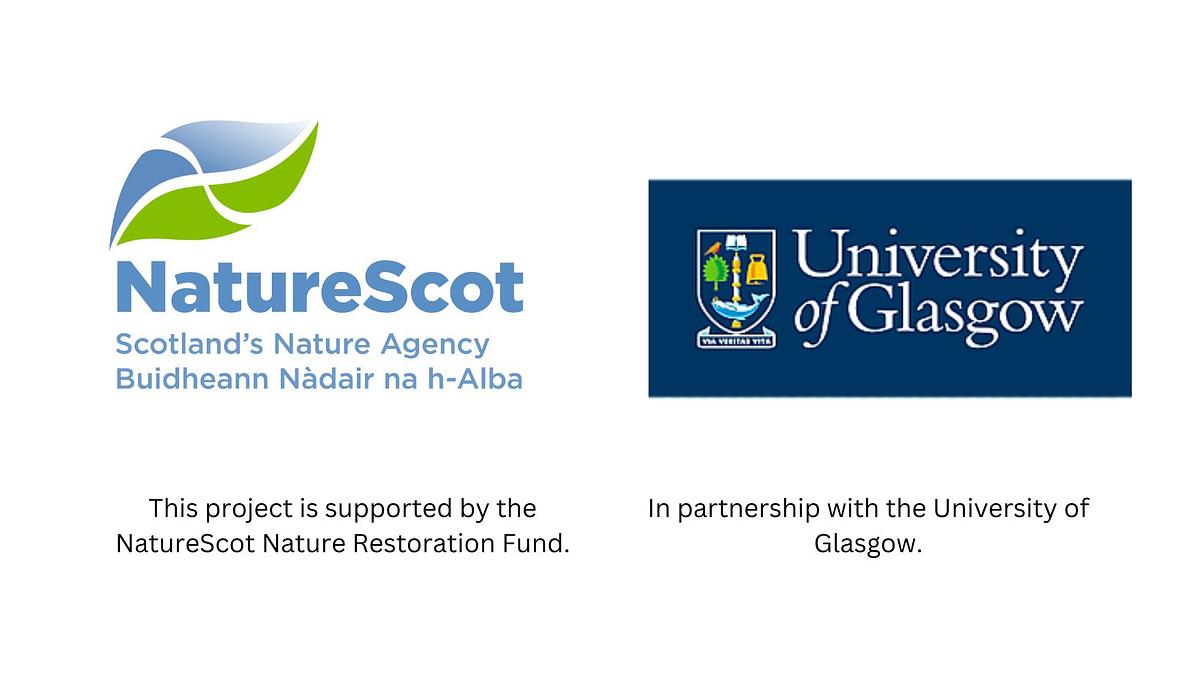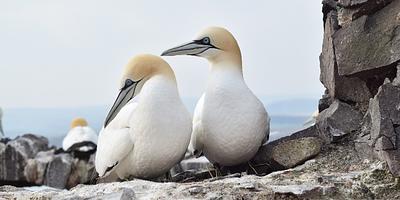
Research on a Changing Rock
Research Spotlight: Are Northern gannet chicks heat stressed?
By Shannon Clifford
This brilliant blog is part of our research spotlight series. For context around this project, read the previous blogs here and here, or go to our Bass Rock Research webpage. Please note that this blog contains descriptions of the symptoms of Avian Flu in gannets, which some readers might find distressing.
I first learned I would be going to the Bass Rock to study gannets at the end of 2021; little did I know it would turn out to be one of the most fascinating and challenging summers of my entire life. I was lucky enough to be involved in the seabird census, surveying seabirds for the RSPB in 2021, which sparked a love and fascination with seabirds and their conservation. As part of my master’s research degree in Ecology and Environmental Biology at the University of Glasgow, I had to choose a research project to immerse myself in for eight months. Out of the large list of projects to choose from within the University, the project studying the impacts of heat stress in Northern gannets (Morus bassanus) chicks was the one that most aligned with my love of seabirds and a long-term interest in the effects of climate change. Under the supervision of Dr Jana Jeglinski and Dr Ruedi Nager, I would have the privilege of working within the largest Gannet colony in the world, studying the impacts of heat stress in gannet chicks on the Bass Rock.
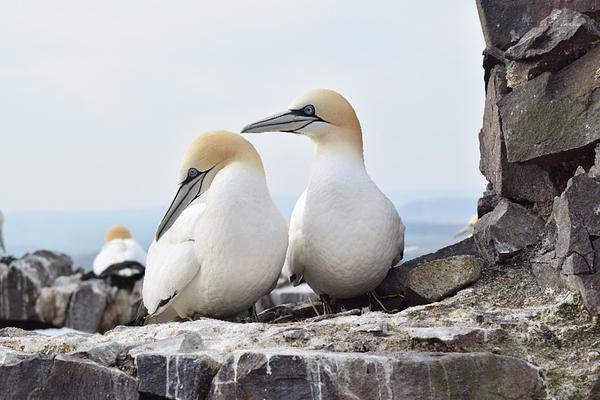
I’ll never forget the first time I visited Bass Rock. The sight, sound, and smell of a colony of approximately 75,000 pairs of gannets is unique and magical (although the smell was awful at times!). Our initial fieldwork visit in May involved preparing the Bass Rock for my main data collection period in summer (June to July). In order to investigate heat stress in gannet chicks and if 2022 was a “hot” year, it was important to have a log of weather changes throughout the season. Therefore, one of the first jobs was to set up a weather station ready to record detailed measurements throughout the summer.
We were also interested in exploring if different nest thermal microclimates affected heat stress in chicks; for example, nests with natural shade were expected to be less heat stressed than nests out in the open with no possibility of shade. I selected three sites that differed in exposure to the elements; two exposed sites and one which had partial shade from the old Chapel building. We set up temperature loggers on nest sites to record fluctuations in temperature throughout the day for the entire breeding season, expecting on my next visit to find gannets sitting on eggs or chicks next to the loggers; little did we know what was around the corner.
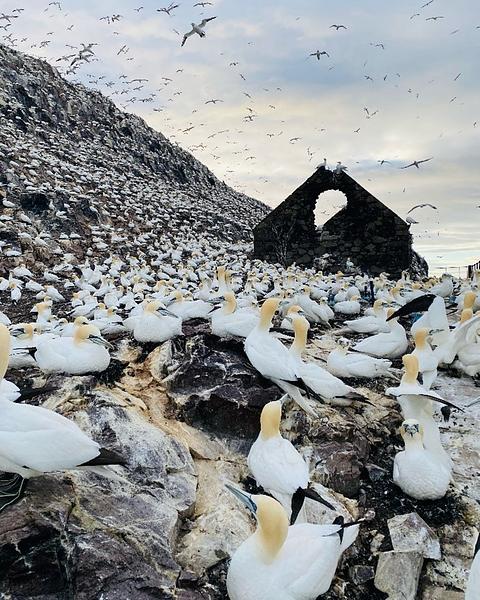
Highly Pathogenic Avian Influenza (HPAI) was first suspected, then subsequently confirmed in the colony before my main fieldwork was due to start in June 2022. At this stage, it was unclear what the impact would be and whether I would be able to continue the research as planned. I knew it would be a challenging and distressing time, but despite this I was keen for the research to go ahead as I thought this information would now be more important than ever. Whilst my main focus would be on collecting data for my project, I also knew I would be one of the few people in a position to study the impact of HPAI on a seabird colony in detail.
To proceed with any research on the rock, we had to follow strict new safety, biosecurity, research protocols to protect ourselves and to safeguard the birds. I collected my data with my fieldwork assistant, Anna Prokopiew. We were warned to expect many dead and dying birds on the Rock, as Scottish Seabird Centre staff members were monitoring the situation as it developed, both in person and via their live cameras. Despite these warnings, it was difficult to prepare for what we encountered. The first few visits were very hard, facing up to the reality of the devastation HPAI can cause a seabird colony. The path up from the boat drop off area to the lighthouse and study area had many sick and dying birds. Birds infected with HPAI exhibit distressing symptoms.
From accounts on social media and videos of the symptoms in other bird species I had some idea of what to expect, however seeing birds in real life dying from this disease was very upsetting to watch. In the later stages of the disease, birds are unresponsive (very unlike the usual territorial behaviour of healthy Gannets). They struggle to stand upright and sometimes have seizures, eventually resulting in death.
Whilst coping with the emotion and shock of seeing these amazing birds suffer, I also had to deal with the changes to my experimental design. One of my planned study areas was completely lost due to HPAI, with only a few nests remaining during the first visit in June. My remaining two study areas had also been heavily impacted by HPAI.
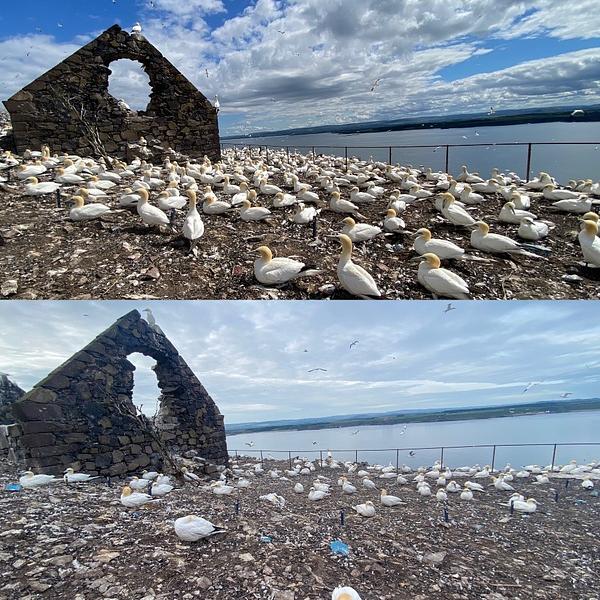
Despite the uncertainty of whether any birds in my remaining study areas would survive, we continued with the planned data collection. I selected 40 nests across the two areas to monitor over the fieldwork period. During each visit, I collected thermal images of each adult and chick in my chosen nests with the thermal camera. Simultaneously, Anna collected behavioural observations using a technique called instantaneous sampling, recording the presence of behaviours at set time intervals. It was difficult to focus on our data collection with the impact of HPAI all around us. However, after the first few visits and through supporting each other, we got into a routine and managed to collect invaluable data on heat stress in Gannets, as well as mortality data on the impact of HPAI.
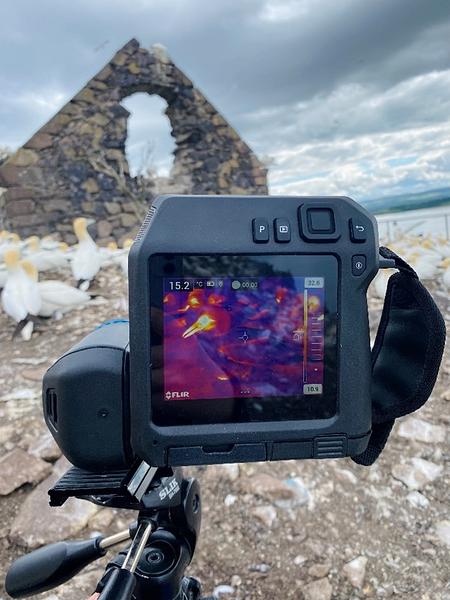
It was such a privilege to be able to monitor nests for an extended time; from watching the eggs hatch and little dinosaur-like Gannet chicks appearing, to watching the chicks get their first fluffy feathers. I wanted more than anything for all the chicks to do well and survive, but sadly many nests failed. Some eggs were left without protection and were predated by the resident Herring Gulls that sneak into the colony and steal the eggs. In other cases, I found chicks dead in the nest, with no parents in the vicinity.
Although Gannets, like other seabird species face many threats, HPAI was an added pressure that further affected nesting success. Many nest failures are likely due to one parent bird being infected with HPAI, leaving the other parent to both protect the chick from predation and the elements, and provide food for the chick and itself. This resulted in the eggs/chicks being left alone and vulnerable in their nests. In total, we carried out eight visits from June to July 2022. Across this time, the 40 nests failed by a staggering 70%. It was heart-breaking to witness this decline and see the loss of so many chicks.
Despite having to juggle the stress of completing my master’s fieldwork in the midst of HPAI and witnessing this devastating disease unfold in one of the most amazing places in the world, I feel extremely grateful to have been a part of this project. Not many people have experienced what it is like to be on Bass Rock, and not many people have seen first-hand the impact of HPAI on a colony. I hope the data I have collected will be an important step towards understanding heat stress in temperate seabirds here in Scotland and the potential impacts that a warming climate will have on these birds.
Acknowledgments
This research was made possible by the generous contributions of various organisations. Thank you to the Scottish Seabird Centre for raising the funds for the necessary equipment needed to carry out this research through the Nature Restoration Fund. The Glasgow Natural History Society (GNHS) and the University of Glasgow also provided grants, without which this research would not have been possible. Thank you to Maggie Sheddan, Jack Dale and John McCarter for their crucial support in navigating the unpredictable weather and being able to access the Bass Rock so many times to carry out the fieldwork.
Header Image Copyright: Shannon Clifford
